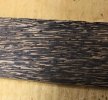Frank Perricone
FRANCO
- Joined
- Jan 12, 2019
- Messages
- 90
Hello Gentlemen. Bought a small length of Black Palm and upon opening the packaging I was puzzled, to say the least. Nice looking but splintery. Weird! OK! On to the internet. Oh. It really is a grass. OK. It's better stabilized. Didn't know that. I should have. I do now! The purveyor might have had a note with the offering. How can I use this? I brushed J-Flex on one side. Nice. Could make a handle and finish with epoxy. Doesn't sound right. Any suggestions?
Franco
And thanks in advance. Gotta go and take couple splinters out.
Franco
And thanks in advance. Gotta go and take couple splinters out.


